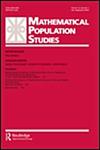墨西哥城市的人口规模遵循幂律分布
IF 1.3
3区 社会学
Q3 DEMOGRAPHY
引用次数: 0
摘要
地理,例如,由于河流、峡谷或山峰的存在,可以细分城市。这些细分提出了这样一个问题:确定城市所占据的区域,决定它们是否是不同建成区的集合体,以及地理上的分离是否仅仅是某个建成区连续体中的突起。城市作为一个行政单位的联盟,允许司法实践,但在卫生等公共政策方面,按建成区进行识别更具操作性。因此,对城市人口的研究需要用客观标准来界定城市。划定一个城市需要了解通勤流,但在缺乏这一信息的情况下,划定城市依赖于它是由紧密的建成区组成的事实。这反映在这些建成区空间范围的凸包络的交叉点上。该算法处理由美国人口普查局(Census Bureau)或墨西哥国家统计与地理研究所(National Institute of Statistics and Geography)提供的包含建成区的多边形顶点坐标。它允许计算多边形的凸壳是否相交。如果是这样,那么被这些多边形包围的建成区就是同一个城市的一部分。其结果是,城市现在反映的是城市地区的地理范围,而不是其行政区域。将这种划分方法应用于墨西哥2020年的人口普查数据,至少有2126名居民的城市地区的人口规模遵循幂律,指数为0.954(标准差= 0.016),而仅考虑人口超过15,000人的城市的行政范围时,情况就不再如此了。本文章由计算机程序翻译,如有差异,请以英文原文为准。
The population sizes of Mexican cities follow a power-law distribution
ABSTRACT Geography, for example because of the presence of rivers, ravines, or peaks, can subdivide a city. These subdivisions raise the question of identifying the area occupied by the city, of deciding whether or not they are aggregates of distinct built-up areas, and whether or not geographical separations are merely asperities in a certain continuum of built-up areas. The city as a union of administrative units allows for jurisdictional practices, but for public policy in health for example, identification by built-up areas is more operational. The study of urban populations thus requires that cities be circumscribed on objective criteria. Circumscribing a city requires knowledge of commuting flows, but in the absence of this piece of information, circumscribing it relies on the fact that it is made up of close built-up areas. This is reflected in the intersection of the convex envelopes of the spatial extent of these built-up areas. The algorithm treats coordinates of the vertices of polygons encompassing built-up areas provided by the Census Bureau for the United States or the National Institute of Statistics and Geography for Mexico. It allows for computing whether convex hulls of polygons intersect or not. If they do, then the built-up areas circumscribed by these polygons are part of the same city. The result is that cities now reflect the geographic extent of urban areas rather than their administrative areas. With this delineation method applied to Mexico’s 2020 census data, the population sizes of urban areas with at least 2,126 inhabitants follow a power law, with exponent 0.954 (standard deviation = 0.016), whereas this is no longer the case when considering only the administrative extents of cities with more than 15,000 inhabitants.
求助全文
通过发布文献求助,成功后即可免费获取论文全文。
去求助
来源期刊

Mathematical Population Studies
数学-数学跨学科应用
CiteScore
3.20
自引率
11.10%
发文量
7
审稿时长
>12 weeks
期刊介绍:
Mathematical Population Studies publishes carefully selected research papers in the mathematical and statistical study of populations. The journal is strongly interdisciplinary and invites contributions by mathematicians, demographers, (bio)statisticians, sociologists, economists, biologists, epidemiologists, actuaries, geographers, and others who are interested in the mathematical formulation of population-related questions.
The scope covers both theoretical and empirical work. Manuscripts should be sent to Manuscript central for review. The editor-in-chief has final say on the suitability for publication.
 求助内容:
求助内容: 应助结果提醒方式:
应助结果提醒方式:


